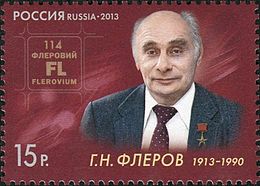Georgy Flyorov
| Georgy Flyorov | |
|---|---|

Georgy Flyorov on a 2013 Russian stamp
|
|
| Born | Georgy Nikolayevich Flyorov 2 March 1913 Rostov-on-Don, Russian Empire |
| Died | 19 November 1990 (aged 77) Moscow, Russian Soviet Federative Socialist Republic, Soviet Union |
| Citizenship | Russia-Soviet Union |
| Nationality | Soviet |
| Fields | Thermal and Nuclear Physics |
| Institutions | Joint Institute for Nuclear Research |
| Alma mater | St. Petersburg State Polytechnic University |
| Known for | Discovery of spontaneous fission, Soviet atomic bomb project |
Georgy Nikolayevich Flyorov (Russian: Гео́ргий Никола́евич Флёров; IPA: [gʲɪˈorgʲɪj nʲɪkɐˈlajɪvʲɪtɕ ˈflʲɵrəf]; 2 March 1913 – 19 November 1990) was a Russian nuclear physicist who was known for the discovery of spontaneous fission. In 2012, element 114 flerovium was named after the research laboratory at the Joint Institute for Nuclear Research bearing his name .
Flyorov was born in Rostov-on-Don and attended the Leningrad Polytechnic Institute (now known as the St. Petersburg State Polytechnic University) and majored in thermal physics and nuclear physics.
He is known for writing to Stalin in April 1942, while serving as an air force lieutenant, and pointing out the conspicuous silence within the field of nuclear fission in the United States, Great Britain, and Germany. Flyorov's urgings to "build the uranium bomb without delay" eventually led to the development of the Soviet atomic bomb project.
He discovered spontaneous fission in 1940 with Konstantin Petrzhak.
...
Wikipedia
